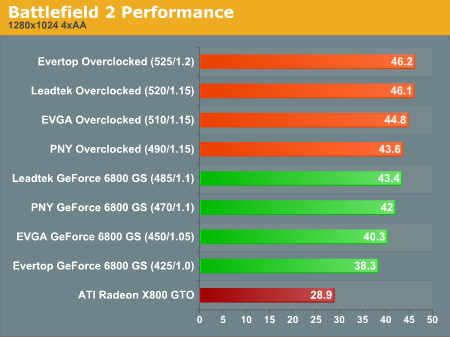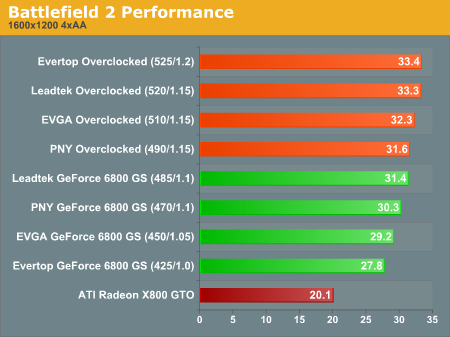The NVIDIA 6800 GS Closer Look: EVGA, Leadtek, PNY, and Evertop
by Josh Venning on January 27, 2006 8:53 AM EST- Posted in
- GPUs
Battlefield 2 Performance
We tested Battlefield 2 with the 1.03 patch and our own custom demo. The demo makes use of multiple vehicles and is very heavy on the GPU. Our tests were performed with all the settings on high and 4xAA enabled.
The good news is that it is almost playable at 1600x1200 with 4xAA enabled. Performance of the stock speed 6800 GS (same as the Evertop out-of-box speed) is much better than that of the X800 GTO without any overclocking or unlocking done to it. This game performs very nicely at 1280x1024 and is more than playable at 1600x1200 without AA enabled.
We tested Battlefield 2 with the 1.03 patch and our own custom demo. The demo makes use of multiple vehicles and is very heavy on the GPU. Our tests were performed with all the settings on high and 4xAA enabled.
The good news is that it is almost playable at 1600x1200 with 4xAA enabled. Performance of the stock speed 6800 GS (same as the Evertop out-of-box speed) is much better than that of the X800 GTO without any overclocking or unlocking done to it. This game performs very nicely at 1280x1024 and is more than playable at 1600x1200 without AA enabled.












56 Comments
View All Comments
superkdogg - Friday, January 27, 2006 - link
This article was good and informative if a consumer is only looking @ 6800GS cards. Now, if they were smart they would consider the 7800GT for more money, and the 6600GT to save money. If they were not opposed to supporting the red team, they could look at the x800gto2 and it's unlockable quad and overclocking that part too. They could also look at the x1600's and the entire x850/800 pro series would not be far from this price range.It's nice to have information available. It's even better when reviewers pull it together for consumers rather than consumers having to do the legwork.
bob661 - Friday, January 27, 2006 - link
Sounds like instant gratification syndrome to me. What wrong with doing the legwork yourself? Especially when it's already been done. Why should AT have to do redo test because of lazy readers, like yourself?andrep74 - Friday, January 27, 2006 - link
One obvious area of testing that was overlooked, and would have been somewhat simple, was to do some CPU scaling: while using the fastest CPU available does remove the CPU from the equation, the fact that these cards are midrange means that people who buy the card will most likely have midrange CPUs, also. Perhaps two or three speeds at "midrange" CPU speeds like 3200, 3500, 3700 would have shed light on the effects of CPU on performance. Interpolation requires at least two to three points of analysis.superkdogg - Friday, January 27, 2006 - link
You're calling me lazy? Hmm. My wife, kids and two jobs don't think so. Well, maybe my wife sometimes.Seriously though. Read my comment. What's the first sentence? Yep, you're right I do say that the article is useful for people who are only interested in the 6800GS. My point is that most consumers would want to compare the 6800GS with other cards in a similar price range and since AT serves consumers, it is probably in the best interest of everybody to focus on a wider segment of the population.
This sort of article was very useful in the days of the MX400's and the GeForce GTS's. Back then, there was only one viable card per price point (ATI's first real card was the 8500's to be honest) and manufacturers didn't just regurgitate the reference design. However, since now there are innumerable cards that could possibly meet an end user's needs, the fact that all decisions are in some way based on relative value, and the fact that most if not all manufacturers use the reference design exclusively, this article's relevance is somewhat limited.
My point is not that the article was poorly written, that it was slanted against ATI, that it was dishonest, or that it does not provide what it says it will. None of those things are true. What I was writing about was whether or not this article needed to be written at all and if it would have been more useful to review more than one graphics card. If you eliminate chance and the fact that one manufacturer uses a Zalman heatsink, and figure in that the GTO is just thrown in for comparison, this is essentially a one-card review, but takes the same amount of time to compile data and write as a 4-5 card review would.
Would it not be more useful to have one widely available 6800GS, a X800 Pro, a 6600GT, a 7800GT, a x800XL, and a x800 GTO (especially the GTO2 and show unlocking), rather than the article as written? I think that it would, and I don't think that you can build an argument that it wouldn't. BTW, don't bother flaming me because I'm through with this since you can't read and understand my first sentence and resort to name calling in titling your response.
superkdogg - Friday, January 27, 2006 - link
But, what I wrote was "Why not write a full-blown midrange comparison?" That is what my title was and that is what I meant and said.My meaning is that there is no point in singling out a 600GS roundup anymore than there is a NForce4 roundup or any other part based on 4 different colors of the reference design. I was stating that it is much more useful to compare different cards than tell us again that overclocks are about the same and that this will vary based on your setup and your particular card.
As far as instant gratification. "Hello, I am the internet. I am here to fulfill your thirst for knowledge. But I won't because it might happen too fast." Umm, don't think so. The whole point of the internet is to have the knowledge at our fingertips. Otherwise why would we read this stuff. Why not better compile the knowledge into a more readily usable form? That was and is my question. Read my comment. I don't rip them for writing a 6800GS roundup. I wonder why the assumption is that knowing the difference between brands is more important than knowing what cards are available in the price range.
Spoelie - Friday, January 27, 2006 - link
If I had one comment I'd say the x1600xt would have been a better choice as a competitor for the 6800gs.However, it pains me to see how the comments always start out with people 'angry' because the review didn't contain the information for their own particular situation. A review can NOT cover every particular base, it is a decision made at the start what to cover. If you think you can do better, write your own article, if not then yes, you will have to do your own legwork. Do not always expect people to figure things out for you.
If the article was named "Vidcard midrange comparison" you'd have reason to complain, now the article does what it set out to do.
This comment is directed to everyone having replied up till now, not anyone in particular.
Bull Dog - Friday, January 27, 2006 - link
Oh right and the X1600XT costs some $40 LESS than the 6800GS. And appropriately, doesn't perform quite as good.deathwalker - Friday, January 27, 2006 - link
This review has missed the mark by failing to include the "AGP" versions of the 6800GS. Test results for the AGP version are important not only because there is still a very large contigent of gamers still using APG graphics supported motherboards but also because the clocking is very different on the AGP versions vs. the PCIe version. Dissapointing that AT had there tunnel vision visors on for this exersize.bob661 - Friday, January 27, 2006 - link
AGP is dead which is why it wasn't tested. This IS an enthusiast site not a J6P site.Patrese - Friday, January 27, 2006 - link
I'd like to see the AGP 6800GS tested anyway. As Anandtech is a worldwide website (as it was said in the article), they should be aware that in less developed countries AGP is still a big deal, even for new computers. Here in Brazil, buying a Semprom 3100+ with Palermo core and putting it to work at 2.5GHz on air is becoming a national sport [sort of :)], and most of them are AGP based systems. It's not cutting edge technology, but still is enthusiast stuff!I'm not a cry-baby though, as I found the review really good (Zalman kicks the stock cooler's a**!). They may test the AGP version on other occasion. It's just a reply for those who think AGP is already dead and gone, specially in this price range.